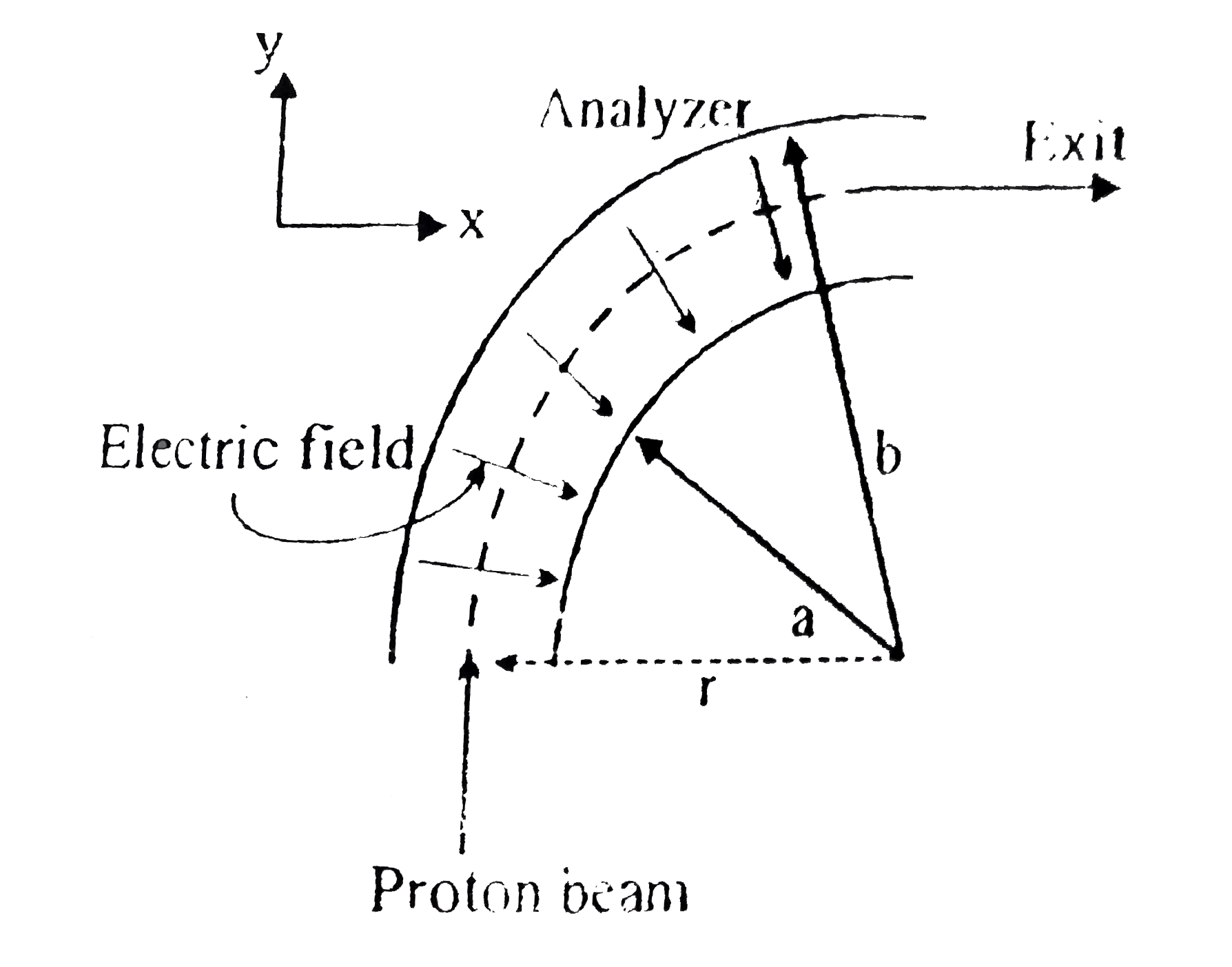Figure shows a schematic view of an electrostatic analyzer. It can sort out charged particles by speed and charge to mass ratio. Spacecraft use such analyzers to characterize charged particles in interplanetary space. Two curved metal plates establish an electric field given by E=E0(br) where E0 and b are positive constants with unit of electric field and length. The field points toward the centre of curvature and r is distance from centre. There is no influence of gravity. Proton (change +e mass 'm') enters along y-axis and exits along x-axis while moving along a circular path.

Speed with which protion is to be projected is 'v' and centripetal acceleration of electron is 'ac' is given by respectively. Mark the correct statement
v=√eE0bm,ac=2emE0(br)
v=√2eE0bm,ac=e2mE0(br)
v=√eE0b2m,ac=2emE0(br)
v=√eE0bm,ac=emE0(br)
The correct Answer is:D
eE=mv2r⇒v=√eE0bm
ac=eEm=emE0(br)
Topper's Solved these Questions
- MASTER PRACTICE PROBLEMBook:BANSALChapter:MASTER PRACTICE PROBLEMExercise:Reasoning
Explore 75 Videos
- MASTER PRACTICE PROBLEMBook:BANSALChapter:MASTER PRACTICE PROBLEMExercise:Multiple objective
Explore 131 Videos
- MASTER PRACTICE PROBLEMBook:BANSALChapter:MASTER PRACTICE PROBLEMExercise:Additional topic
Explore 70 Videos
- FLUID MECHANICSBook:BANSALChapter:FLUID MECHANICSExercise:PYQS AIEEE
Explore 10 Videos
- SEMICONDUCTORSBook:BANSALChapter:SEMICONDUCTORSExercise:CBSE Question
Explore 32 Videos
Similar Questions
A positive charge particle to charge q& mass m is released at origin.There are unifrom magnetic and electric field in the space given by →E=E0ˆj&→B=B0ˆk, where E0&B0 are constants.Find the y coordinate of the particle at time t.
View SolutionElectric Field: Introduction | Force on charged particle due to field | Field due to point charge | E vs X plots
View Solution
Knowledge Check
Figure shows a schematic view of an electrostatic analyzer. It can sort out charged particles by speed and charge to mass ratio. Spacecraft use such analyzers to characterize charged particles in interplanetary space. Two curved metal plates establish an electric field given by E=E0(br) where E0 and b are positive constants with unit of electric field and length. The field points toward the centre of curvature and r is distance from centre. There is no influence of gravity. Proton (change +e mass 'm') enters along y-axis and exits along x-axis while moving along a circular path.

Mark the INCORRECT option:AWork done by electric field on proton is zero.BIf v=√2eE0bm proton may strike outer surface of analyzer.Cif v=√2eE0bm proton may strike inner surface of analyzer.Dif an electron is released with zero initial velocity from inner surface of analyzer it will strike outer surface with velocity v=√2eE0bmeln(ab),whereme is mass of electron.Figure shows a schematic view of an electrostatic analyzer. It can sort out charged particles by speed and charge to mass ratio. Spacecraft use such analyzers to characterize charged particles in interplanetary space. Two curved metal plates establish an electric field given by E=E0(br) where E0 and b are positive constants with unit of electric field and length. The field points toward the centre of curvature and r is distance from centre. There is no influence of gravity. Proton (change +e mass 'm') enters along y-axis and exits along x-axis while moving along a circular path.

Mark the correct option.AIf E0 is made larger then in order to maintain same trajectory initial speed has to be decreased.BIf proton enters closer to the inner surface it will require smaller speed to follow circular trajectory.CIt does not matter where the protons enter the device it requires same speed to follow circular trajectory.DA deuteron (charge+e mass 2m)will require greater speed as compared to proton to follow circular trajectory.How does the electric field (E) between the plates of a charged cylindrical capacitor vary with the distance r from the axis of the cylinder ?
AE∝1r2BE∝1rCE∝r2DE∝r
A charge particle is moving along positive y-axis in uniform electric and magnetic fields
E=E0ˆk
and B=B0ˆi
Here E0 and B0 are positive constants.choose the correct options.
View SolutionTwo charges e and 3e are placed at a distance r. The distance of the point where the electric field intensity will be zero is
View SolutionTwo charge 9e and 3e are placed at a distance r. The distance of the point where the electric field intensity will be zero is :
View SolutionA particle of charge q and mass m moves rectilinearly under the action of an electric field E=α−βx. Here, α and β are positive constants and x is the distance from the point where the particle was initially at rest. Then, the
View SolutionThe motioin of a charged particle can be used ot distinguish between a magnetic field and electric field in a certain region by firing the charge
View Solution

